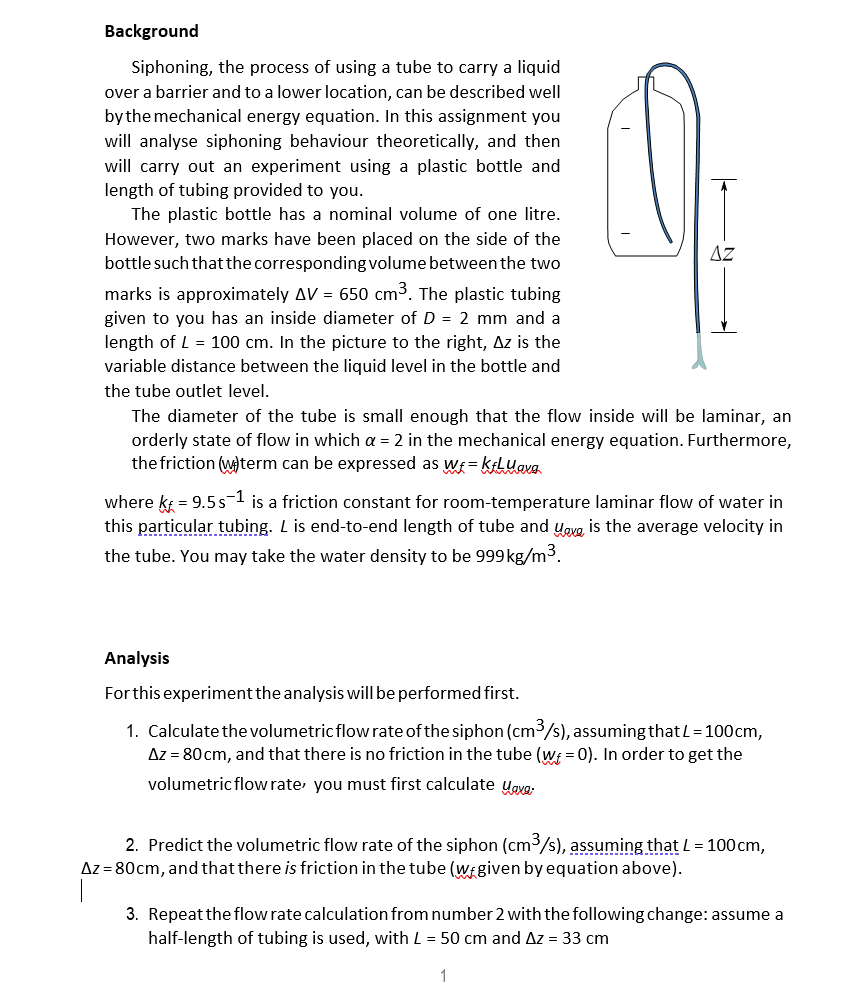1. Calculate the volumetricflow rate of the siphon (cm³/s), assuming that L= 100cm, Az = 80 cm, and that there is no friction in the tube (w = 0). In order to get the volumetric flow rate, you must first calculate ygva, 2. Predict the volumetric flow rate of the siphon (cm³/s), assuming that L = 100 cm, Az = 80cm, and that there is friction in the tube (Wgiven by equation above). 3. Repeatthe flow rate calculation from number 2 with the following change: assume a half-length of tubing is used, with L = 50 cm and Az = 33 cm
1. Calculate the volumetricflow rate of the siphon (cm³/s), assuming that L= 100cm, Az = 80 cm, and that there is no friction in the tube (w = 0). In order to get the volumetric flow rate, you must first calculate ygva, 2. Predict the volumetric flow rate of the siphon (cm³/s), assuming that L = 100 cm, Az = 80cm, and that there is friction in the tube (Wgiven by equation above). 3. Repeatthe flow rate calculation from number 2 with the following change: assume a half-length of tubing is used, with L = 50 cm and Az = 33 cm
Principles of Heat Transfer (Activate Learning with these NEW titles from Engineering!)
8th Edition
ISBN:9781305387102
Author:Kreith, Frank; Manglik, Raj M.
Publisher:Kreith, Frank; Manglik, Raj M.
Chapter5: Analysis Of Convection Heat Transfer
Section: Chapter Questions
Problem 5.54P
Related questions
Question
Question in image. i need help with q 2

Transcribed Image Text:Background
Siphoning, the process of using a tube to carry a liquid
over a barrier and to a lower location, can be described well
bythe mechanical energy equation. In this assignment you
will analyse siphoning behaviour theoretically, and then
will carry out an experiment using a plastic bottle and
length of tubing provided to you.
The plastic bottle has a nominal volume of one litre.
However, two marks have been placed on the side of the
bottle such that the corresponding volume between the two
AZ
marks is approximately AV = 650 cm3. The plastic tubing
given to you has an inside diameter of D = 2 mm and a
length of L = 100 cm. In the picture to the right, Az is the
variable distance between the liquid level in the bottle and
the tube outlet level.
The diameter of the tube is small enough that the flow inside will be laminar, an
orderly state of flow in which a = 2 in the mechanical energy equation. Furthermore,
the friction (wterm can
expressed as wf = kFLuavg
where k = 9.5s-1 is a friction constant for room-temperature laminar flow of water in
this particular tubing. L is end-to-end length of tube and yovg is the average velocity in
the tube. You may take the water density to be 999kg/m3.
Analysis
Forthis experiment the analysis will be performed first.
1. Calculate the volumetric flow rate of the siphon (cm3/s), assuming that L=100cm,
Az = 80 cm, and that there is no friction in the tube (w = 0). In order to get the
volumetric flow rate, you must first calculate ygvg:
2. Predict the volumetric flow rate of the siphon (cm3/s), assuming that L = 100cm,
Az = 80cm, and that there is friction in the tube (wi given by equation above).
3. Repeat the flow rate calculation from number 2 with the following change: assume a
half-length of tubing is used, with L = 50 cm and Az = 33 cm
1
Expert Solution
This question has been solved!
Explore an expertly crafted, step-by-step solution for a thorough understanding of key concepts.
Step by step
Solved in 2 steps

Knowledge Booster
Learn more about
Need a deep-dive on the concept behind this application? Look no further. Learn more about this topic, mechanical-engineering and related others by exploring similar questions and additional content below.Recommended textbooks for you

Principles of Heat Transfer (Activate Learning wi…
Mechanical Engineering
ISBN:
9781305387102
Author:
Kreith, Frank; Manglik, Raj M.
Publisher:
Cengage Learning

Principles of Heat Transfer (Activate Learning wi…
Mechanical Engineering
ISBN:
9781305387102
Author:
Kreith, Frank; Manglik, Raj M.
Publisher:
Cengage Learning